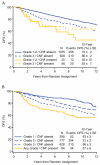Prognostic and predictive impact of central necrosis and fibrosis in early breast cancer: results from two International Breast Cancer Study Group randomized trials of chemoendocrine adjuvant therapy
- PMID: 19280340
- PMCID: PMC3588888
- DOI: 10.1007/s10549-009-0360-y
Prognostic and predictive impact of central necrosis and fibrosis in early breast cancer: results from two International Breast Cancer Study Group randomized trials of chemoendocrine adjuvant therapy
Abstract
A minority of early invasive breast cancers show a pattern of central necrosis and fibrosis (CNF). Previous studies have documented an adverse prognostic impact and association with other adverse pathological features, but its predictive importance for therapy selection is unknown. We examined the prognostic and predictive value of CNF in two randomized clinical trials comparing chemoendocrine therapy with endocrine therapy alone in patients with node-negative breast cancer. A total of 1,850 patients randomly assigned to treatment groups comparing endocrine with chemoendocrine therapy, and with centrally-assessed CNF, ER, PgR and HER2 were included in the analytic cohort. The median follow up was 10 years. CNF was present in 84 of 1,850 trial patients (4.5%). It was associated with tumor characteristics suggesting poor outcome, but was an independent adverse factor for disease-free survival. In the presence of CNF outcome was worse regardless of tumor grade, whereas in the absence of CNF, patients with grade 3 tumors had poorer outcome than those with grade 1-2 tumors. Among patients with estrogen receptor-absent tumors chemoendocrine therapy was superior to endocrine therapy alone only in the absence of CNF [HR (chemoendocrine:endocrine) = 0.46 in CNF-absent, 0.90 in CNF-present], while among those with receptor-positive disease chemoendocrine therapy was beneficial only in the presence of CNF [HR = 0.34 CNF-present, 0.96 CNF-absent]. The results suggest that the presence of CNF reflects a biological difference in early breast cancer that is important in modulating the efficacy of standard therapies. Accordingly we believe that its presence should be routinely reported.
Figures



References
-
- Fisher ER, Gregorio RM, Fisher B, et al. The pathology of invasive breast cancer. A syllabus derived from findings of the National Surgical Adjuvant Breast Project (protocol no. 4) Cancer. 1975;36:1–85. - PubMed
-
- Hasebe T, Tsuda H, Hirohashi S, et al. Fibrotic focus in infiltrating ductal carcinoma of the breast: a significant histopathological prognostic parameter for predicting the long-term survival of the patients. Breast Cancer Res Treat. 1998;49:195–208. - PubMed
-
- Hasebe T, Mukai K, Tsuda H, et al. New prognostic parameter of invasive ductal carcinoma of the breast: clinico-pathological significance of fibrotic focus. Pathology International. 2000;50:263–272. - PubMed
-
- Tsuda H, Takarabe T, Hasegawa F, et al. Large, central acellular zones indicating myoepithelial tumor differentiation in high-grade invasive ductal carcinomas as markers of predisposition to lung and brain metastases. Am J Surg Path. 2000;24:197–202. - PubMed
Publication types
MeSH terms
Substances
Grants and funding
LinkOut - more resources
Full Text Sources
Medical
Research Materials
Miscellaneous

